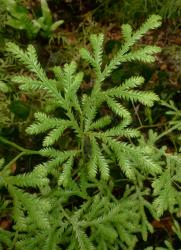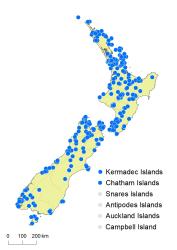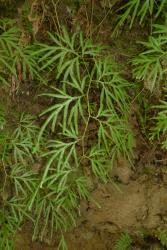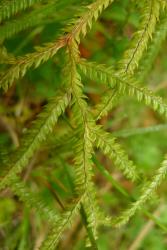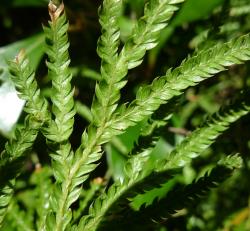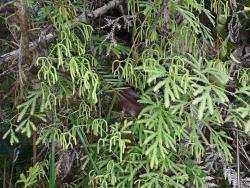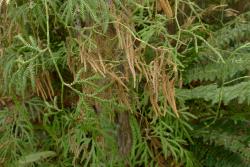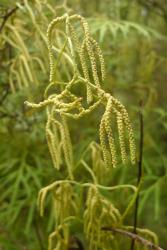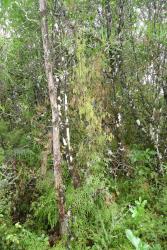- Taxon
- Gallery
- ≡ Lepidotis volubilis (G.Forst.) Rothm., Feddes Repert. Spec. Nov. Regni Veg. 54: 67 (1944)
- ≡ Pseudodiphasium volubile (G.Forst.) Holub, Folia Geobot. Phytotax. 18: 442 (1983)
Horizontal stems dichotomously branching many times, scrambling widely or climbing, 0.8–2.0 mm diameter, bearing roots at intervals; leaves widely spaced, appressed, linear, peltate. Branches from main stems spreading horizontally, monopodial, glabrous, dimorphic; sterile branches flattened in one plane with larger lateral leaves and smaller dorsal and ventral leaves; fertile branches with short linear leaves appressed to stem, bearing pendulous strobili at their apices. Sterile leaves dimorphic, flattened in one plane, with 2 rows of larger lateral leaves, 2 rows of smaller leaves on the dorsal surfaces, and 1 row on the ventral surface, dull green; lateral leaves sigma-shaped, apices acuminate, margins entire, bases decurrent, 2.5–5.0 mm long, 0.5–1.5 mm wide, tending to curl downwards; dorsal leaves linear, apices acuminate, margins entire, bases adnate, 1.5–4.0 mm long, 0.1–0.4 mm wide; ventral leaves similar to the dorsal leaves but shorter, 1.0–1.9 mm long. Sporophylls deeply concave, virtually unchanged at maturity, broadly ovate with long acuminate scarious apices, 1.5–2.2 mm long, 0.7–1.3 mm wide, with coloured centres and minutely toothed membranous margins, bases adnate, aggregated into strobili. Strobili solitary or paired, sometimes dichotomously divided 1–3 times, pendent, yellow becoming brown with age, 5–160 mm long, 1.3–3.5 mm wide, terminal on branchlets.
Lycopodium volubile is a scrambling or climbing plant commonly found in open forest or scrub. It is one of two species of New Zealand Lycopodiaceae that have branches bearing dimorphic sterile leaves flattened in one plane. There are two rows of larger lateral leaves and additional rows of linear leaves on the ventral and dorsal surfaces. It is easily distinguished from L. scariosum, which also has flattened branches and dimorphic leaves, but has smaller linear leaves only on the ventral surfaces. Lycopodium volubile is distinguished from all other species by having dimorphic sterile and fertile branches, the latter bearing clusters of pendulous strobili, paired or solitary at the end of each axis.
North Island: Northland, Auckland, Volcanic Plateau, Gisborne, Taranaki, Southern North Island.
South Island: Western Nelson, Sounds-Nelson, Marlborough, Westland, Canterbury, Otago, Southland, Fiordland.
Kermadec Islands, Three Kings Islands, Chatham Islands, Stewart Island.
Altitudinal range: 0–1050 m.
Lycopodium volubile occurs on the Kermadec and Three Kings Islands, and in lowland to montane areas throughout much of the North Island, but is rare in the Gisborne Ecological Province. It grows from near sea-level, up to 1050 m on Mt Pihanga south of Lake Taupō. In the South Island it occurs in lowland and montane areas throughout, but is uncommon in drier parts of inland Marlborough, South Canterbury and Otago. It reaches 900 m at Jordan Stream, Marlborough. It extends to the Chatham Islands and Stewart Island.
Also Malay Peninsula, Borneo, Papua New Guinea, Solomon Islands, Vanuatu, New Caledonia. It is doubtfully recorded from Australia (Queensland) (Field & Renner 2019).
Lycopodium volubile is a scrambling and climbing plant found in open kauri, podocarp, broadleaved and beech forest, on forest margins, under mānuka and kānuka, in regenerating scrub and forest, among bracken and in tussock. It grows on road and track banks, on river banks, in ditches, on slip faces, on swampy or peaty ground, on stabilised dunes and in open areas in forest.
The name Lycopodium durvillaei Bory used by Richard (1832), and combinations based on it, is now regarded as a species of Selaginella. Citations of L. durvillaei sensu Richard by New Zealand Flora writers are mostly misidentifications of L. volubile.



